Friday, February 17, 2006
Mad For Madison
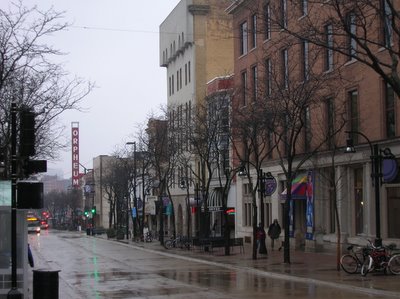 State Street, Madison on a rainy Saturday. Why didn't I take pictures the day before when it was so sunny?! Oh yeah, too busy enjoying FAC and $2 pitchers.
State Street, Madison on a rainy Saturday. Why didn't I take pictures the day before when it was so sunny?! Oh yeah, too busy enjoying FAC and $2 pitchers. Apparently, only lunatics tool around Madison with cameras on a rainy, raw 33 degree day. I assure you the city has so much more life than the following pictures depict!
Apparently, only lunatics tool around Madison with cameras on a rainy, raw 33 degree day. I assure you the city has so much more life than the following pictures depict!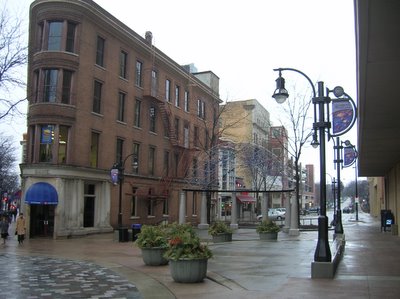 A Little bit of sun would do this plaza some good.
A Little bit of sun would do this plaza some good. From any angle, the capital provides a tremendous vista termination. Even in crappy weather!
From any angle, the capital provides a tremendous vista termination. Even in crappy weather! Tough guys in a beautiful building. The capital!
Tough guys in a beautiful building. The capital! This Copp's grocery store is designed to help define the urban character within the town center. Unfortunately, many of the storefronts remain vacant, and the architecture of most retail building is homogenous and suburban-esque. Time will should heal its current ills.
This Copp's grocery store is designed to help define the urban character within the town center. Unfortunately, many of the storefronts remain vacant, and the architecture of most retail building is homogenous and suburban-esque. Time will should heal its current ills.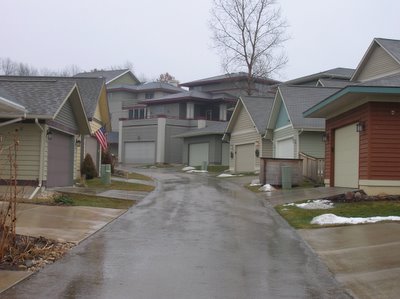 An alley in Middleton Hills, WI. Excellent deflection!
An alley in Middleton Hills, WI. Excellent deflection!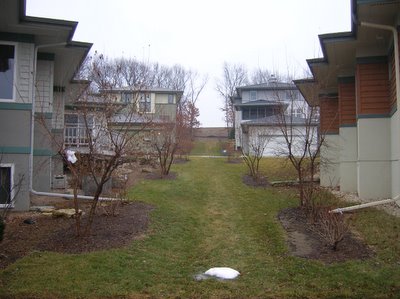 Public right of way already being worn into permanence.
Public right of way already being worn into permanence.Middleton Hills, WI
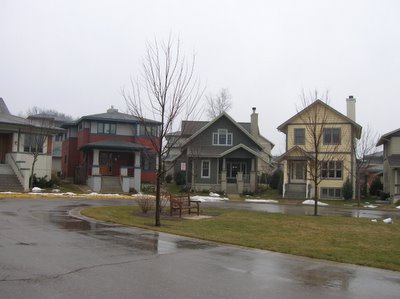 A Close in DPZ designed Middleton Hills, WI
A Close in DPZ designed Middleton Hills, WI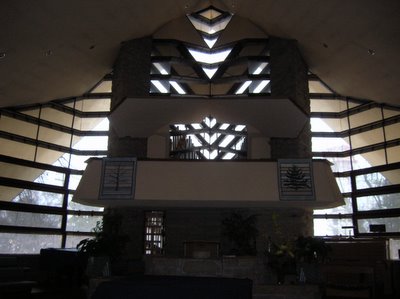 Frank Lloyd Wright Methodist Church, Madison WI
Frank Lloyd Wright Methodist Church, Madison WIThree weeks ago today I joined two of my Michigan planning buddies for a road trip from Ann Arbor, MI to Madison, Wisconsin. We did so for a few reasons, the first being that my friend Alex, who bleeds Badger red, wanted to return to his alma mater for his birthday weekend. Second, both my other friend (Ben) and I were sick and tired of hearing Alex sing the praises of his former place of residence without having a frame of reference. Finally, we all needed to get the hell out of Ann Arbor for a weekend and find some real urban energy, which Alex promised Madison had in spades. With that we were off.
From the moment we got off the perpetually flat and uninspiring series of midwestern highways that somehow got us from eastern Michigan to central Wisconsin in 6 hours, we entered John Nolen Drive, which leads right into the heart of Madison. From that moment on Ben and I sensed that Alex was not exaggerating. Madison is a special place. I will try to keep the gushing to a minimum, but the city is magnificent. The visual scenery around the isthmus, the lakes, and the capital is incredibly beautiful. The energy of the city is three times more intense than in Ann Arbor. The social scene more robust. The street characters more peculiar. The bars more lively. And the bike lanes, wow how I long for Madison's bike lanes! Yes, Madison has a true sense of place.
Throughout the weekend we walked the rainy streets like true urbanists and passed judgement on just every about every physical aspect of the city. And with knowledge on just about every new and planned University and City development, Alex proved to be an incredible tour guide. Moreover, we got a chance to drive out a few miles to check out Middleton Hills, a DPZ project near full buildout just outside the city limits. Overall, the trip was fantastic. We ate, drank, and critiqued street widths and building envelopes. A getaway of proper proportions for proper urbanists. Sadly, the weekend came to a close all too soon. Nonetheless, our time in Madison was enough to prove to me that as far as mid-western cities go - Chicago excluded - Madison cannot be topped.
Wednesday, February 08, 2006
The Real Story...
Normally, I do not like to post random articles on this blog. However, with all of the skepticism, false reporting, and controversy surrounding the Mississippi Renewal Charettes, I felt that this op-ed by Biloxi Sun Herald publisher Ricky Mathews was both timely and informative to those throughout the planning community. Check it out!
Ricky Mathews, Publisher of the Biloxi Sun Herald and Vice-Chairman of the Governor's Commission on Recovery, Rebuilding, and Renewal after Hurricane Katrina, argues that Andres Duany and other New Urbanists have been critical to the early success of rebuilding efforts in Mississippi, providing citizens not only with the hope of recovery, but with master planning that has inspired confidence in a bigger and better Gulf Coast community, all while respecting local traditions.
It has been five months since Hurricane Katrina altered the landscape of the Gulf Coast in Mississippi and Louisiana and changed forever the lives of those of us who live here. For understandable reasons, the national focus has been on the post-Katrina challenges in New Orleans. But it's important to remember that New Orleans suffered a flooding disaster precipitated by a hurricane. South Mississippi got the hurricane.
A storm surge exceeding 30 feet leveled structures and ripped apart the infrastructure for nearly 100 miles along our coastline. Some 50 million cubic yards of debris must be removed. More than 30,000 families now call FEMA trailers home, with thousands more waiting to get trailers. Our South Mississippi economy, leading the state prior to Katrina, is sputtering with near-record unemployment and reconstruction costs in the billions. Visitor after visitor has told me this is a see-it-to-believe-it experience. You can't truly understand the magnitude of destruction -- or the rebuilding job ahead of us -- unless you're here to see for yourself.
And yet there's something else you might have to experience first-hand to see its potential. Amid the rubble, hope grows. The reason is, we have a plan.
Because I am both publisher of South Mississippi's principal newspaper, the Sun Herald, and vice-chairman of the privately funded Governor's Commission on Recovery, Rebuilding, and Renewal, I've been in a unique position to watch -- and to encourage -- this transition from despair. It began in mid-October with the Mississippi Renewal Forum, in which architect/planner Andres Duany led more than 100 international specialists and a like number of their colleagues from Mississippi in a six-day charrette sponsored by the Commission and organized by the Congress for the New Urbanism. Those six days of intense planning produced sets of principles, process suggestions, and actual plans for 11 communities in the three coastal Mississippi counties.
At a public meeting shortly after the Forum, someone asked me to explain how we could think about the future when we were still in the recovery mode. It's the question that remains such a tough one for New Orleans officials. For us, the answer lies in the genius of the Governor's Commission's effort. In order to get out of this mess we are in, we have to have an approach that matches the depth and breadth of the effects of the storm. Katrina didn't target one sector of our lives or one class of our citizens or one stage of our preparations. It didn't wait on our readiness to cope before escalating to the next level of destruction. Katrina was a comprehensive, equal-opportunity force. And we have to deal with its aftermath with comprehensive strategies. We have to recover and rebuild at the same time; because, the fact is, each short-term recovery decision has critical long-term rebuilding effects.
Duany and the New Urbanist planners, engineers, and other specialists have taken their shots along the way, usually from critics outside Mississippi and often from people who didn't bother to read the reports of the Forum teams. Many of us who worked on a day-to-day basis with the New Urbanists were especially offended at the suggestion their agenda was to create a playground for the rich at the expense of cultural diversity, regional tradition, and working class neighborhoods. What the New Urbanists proposed was just the opposite. Every plan was rooted in research and discussion with locals about traditions -- including design traditions -- citizens most wanted to preserve. And I saw first-hand the passion of these planners to protect and to rebuild neighborhoods such as those settled by working-class Yugoslavian, French, Vietnamese and African American citizens in East Biloxi.
Too many in the news media haven't yet understood the scope of what was lost or the ambitions we have to build back better than before. We have whole cities to re-imagine and to reconstruct. Every social and economic issue we may have ducked before the storm is now in plain site. But what is different about where we are right now from where we were in September and perhaps for years prior to Katrina, is that, thanks to the Commission's foresight, the courage of our citizens, and the expertise of the New Urbanists, we have a plan. What's more, we have increasingly reasonable expectations that we can implement its key components.
What the New Urbanists brought to the table was hope. They brought a belief that the obliterated communities that make up South Mississippi could emerge bigger and better. They introduced common-sense principles and approaches to planning, like the SmartCode that links so many of our rebuilding ambitions together and can help us recapture the essence of what was lost. They gave us a strong understanding of how to create a sense of place through design. And they demonstrated how synergies inspired by thoughtful design multiply value that can be measured in classic economic development terms and in the quality of life enjoyed by a community's citizens.
If you're reading and viewing only reports of the struggles in New Orleans, these rising expectations on the "other" Gulf Coast will seem beyond imagining. But there are plenty of us who have been eyewitnesses to this beginning transformation. Every day more of our citizens and their leaders emerge form the Katrina fog and begin to see the value of the New Urbanist approaches and the Governor's Commission recommendations that reflected so many of them. Many of those ideas are already finding their way into rebuilding strategies in individual towns and counties. And I can assure you that, as time goes on, more and more will begin to get their hearts and minds around these gifts of hope and apply their energies to implementing them in ways that will create a story of recovery, discovery and renewal never before seen in American history.
Tuesday, February 07, 2006
Hooray, Suburbia

This picture of me was snapped in the Fall of 2005 on a site visit to Dexter, MI. I must admit, I was thoroughly impressed by the ineptitude of whoever developed this trite suburbo pod of poorly constructed, yet expensive housing.
Coming Soon.... A review of Middleton Hills, a TND designed by DPZ that I visited last weekend. I promise it is more inspirational than this. I will also include pictures of Middleton Hills and downtown Madison, WI. Faaaaaaaantastic.